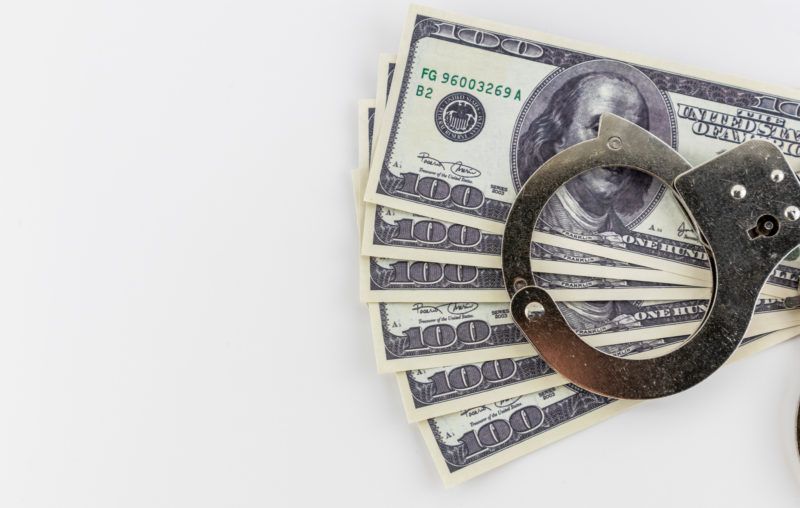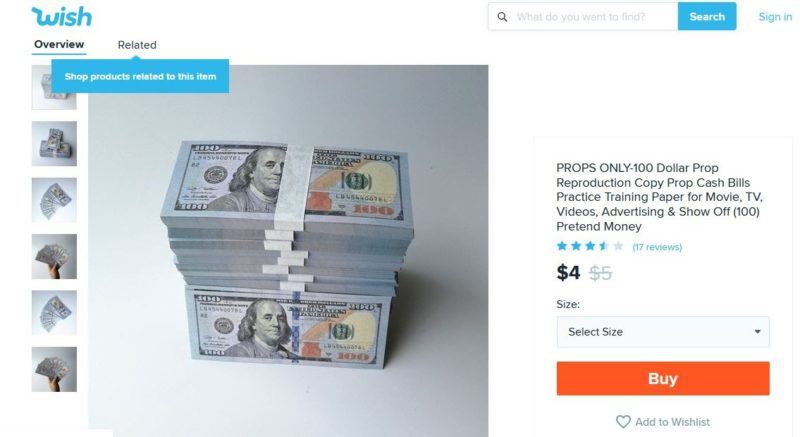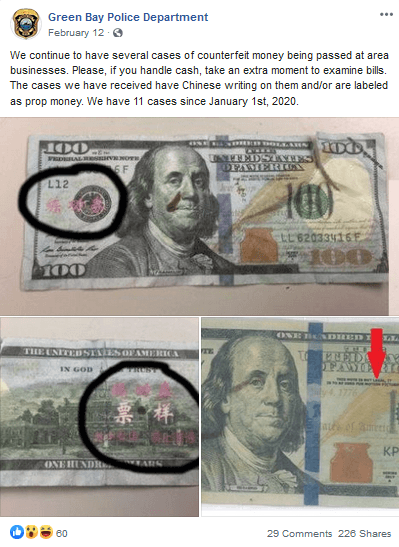Should Those Passing Counterfeits be Treated like Counterfeiters?

Law enforcement agencies around the world treat attempts to spend, or “utter,” counterfeit currency as a serious crime–sometimes unreasonably. In Switzerland, an 8-year old boy recently tried to spend pretend euros. The shop notified the police. Mugshots were taken. And, while not charged, the boy will reportedly have a Swiss police record until 2032.
A few days before the boy’s mugshots were taken, George Floyd was killed by Minneapolis police after allegedly trying to buy cigarettes with a counterfeit $20 bill. In the U.S., passing fake currency is a serious offense. The U.S. Secret Service, which today is known for protecting the president, was originally created to track down counterfeiters.
A wave of fake U.S. bills has hit the U.S. in recent years, These notes, which are printed in China, can be bought on sites like Amazon or Wish.com. They are advertised as prop or training money. One can pick up 10,000 fake Benjamins for around $5.

The notes are relatively easy to spot. They have Chinese characters on them. Liàngōng zhuānyòng (练功专用), which appears on some notes, means “exclusively for use in practice”.
Nevertheless, there is a constant stream of articles in American media about these notes being passed at shops. There are literally hundreds of cases–far too many to list. But some recent examples occured in Faribault, Minnesota; Sioux City, Iowa; Green Bay, Wisconsin; Oklahoma City, Oklahoma; Mount Airy, North Carolina; and Branson, Missouri.

Cheap Chinese knock-offs began proliferating on Amazon and eBay in 2015. And the problem appears to be getting worse. According to the U.S. Secret Service, there was a 120% increase in the passing of Chinese character notes in 2019. Approximately 12% of the $103.4 million in counterfeit money passed in 2019 is Chinese note money or “for motion picture use,” says U.S. Secret Service Resident Agent Cary Dyer.
To cope with the influx of Chinese character notes, the U.S. Secret Service launched “Operation Quick Glance” at the end of 2019. The goal of Operation Quick Glance is to inform U.S. retailers about easy-to-detect fake Motion Picture notes and foreign writing replicas.
Since the debut of Operation Quick Glance, U.S. Customs and Border Protection has announced three seizures of Chinese character notes in transit: $351,000 in Milwaukee; $252,000 in Cincinnati; and $900,000 in International Falls, Minnesota.
Title 18 §472 of the United States Code punishes anyone guilty of “uttering counterfeit obligations or securities.” Prior to 2001, uttering fake currency carried a maximum jail term of 15 years. With the passage of the U.S. Patriot Act, however, penalties on all activities relating to counterfeiting were jacked up. Today, one might serve up to 20 years in jail for attempting to spend a counterfeit. Actual counterfeiters–the people who design and print the notes–are subject to the same punishment.
The U.S.’s strict treatment of passing fake currency is not unique. In Canada, uttering counterfeit currency is an indictable offence carrying up to 14 years in jail. This puts the penalty for uttering on par with counterfeiting, which also carries a 14-year term.
Here’s the problem: currencies circulate. One might accept a fake note as change and, not knowing it is fake, pass it on to someone else. It is an innocent mistake. But it is also grounds to suspect that a crime has been committed. And not just a minor misdemeanor. In the U.S., knowingly passing counterfeit money is a Class C Federal felony.
Uttering fake currency certainly deserves to be punished. It is a form of theft. From the shopkeeper’s perspective, there is little difference between being duped by a fake $20 and having $20 worth of goods stolen outright. But how big a punishment does uttering deserve?
Counterfeiting often attracts dedicated specialists associated with organized crime. To make a profit from counterfeiting large batches of high quality fakes, a criminal organization must get them into circulation. They usually set up networks of “passers” to do this, or sell the notes on to other gangs that operate these networks. If there is a big penalty on uttering, counterfeiters must pay more to passers or sell fakes at a steeper discount. Hence, criminalizing uttering reduces the profit of organized counterfeiting operations and, in doing so, acts as a deterrent.
Unfortunately, laws against uttering have a big blast radius. To begin with, they catch up innocent people who are accidentally engaging in transactions involving counterfeit bills. It is not just Swiss children who play money at risk. I inadvertently tried to spend a fake $5 bill at a corner store ten years ago, only to be notified that it was a fake. What a shock! If a law casts suspicion on a large number of innocent people, perhaps the penalty for conviction shouldn’t be too high.
Secondly, many people who are guilty of uttering currency don’t belong to organized crime rings. Those purchasing Chinese character notes to pass on, for example, are often casual criminals or thrill seekers. They don’t typically merit being treated like Class C felons.
Cash isn’t what it used to be. When anti-uttering laws were first written, coins and banknotes were the main payment options. These days, electronic forms of payment are replacing paper ones. Large denominations, like the $500 bill and the 500 euro note, are no longer being printed. In the U.S., the highest denomination note is the lowly $100, which has lost much of its heft over the years. In 1969, a $100 bill bought what today would cost around $680.
In sum, it seems odd that the crime of uttering currency is considered to be so grave an offense in this day and age. I’m not saying George Floyd’s death would not have occurred if uttering fake currency had been classified as a minor misdemeanour instead of a major felony. But reducing the punishment might cause law enforcement officers to approach cases of uttering as they do other less serious, non-violent offenses. A much smaller pall of suspicion would be thrown over people who are typically either not guilty at all or, if they are, are small-time criminals, not hardened mafia members.
As someone who once tried to pass a fake five, that seems like a good thing to me.












